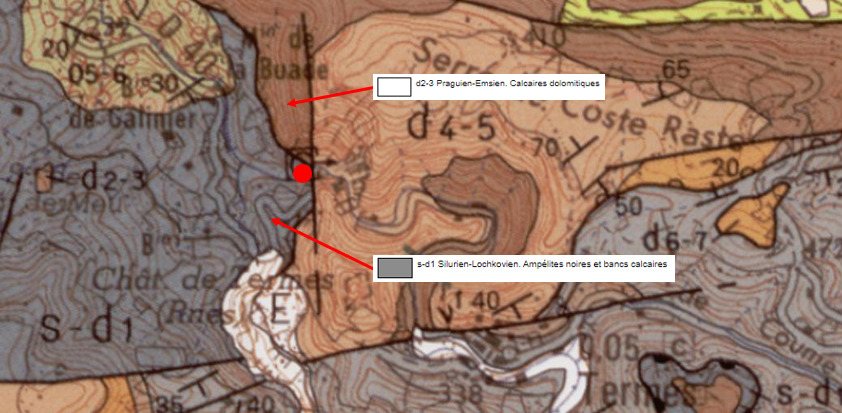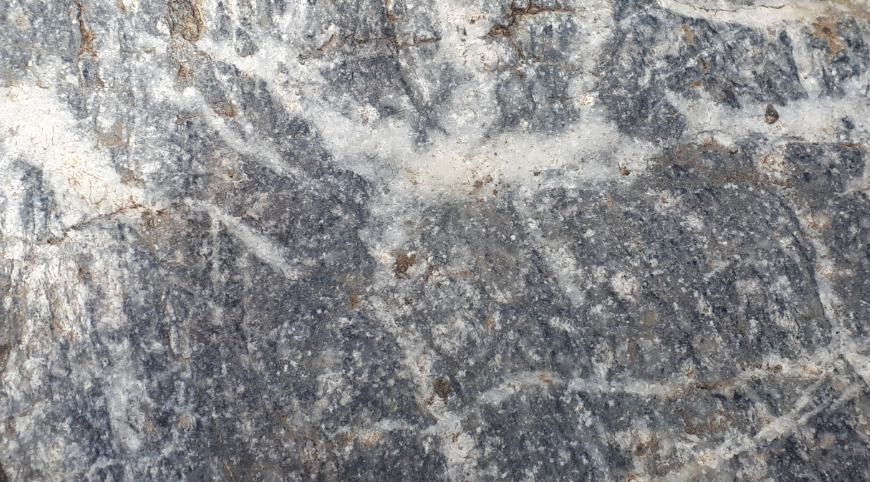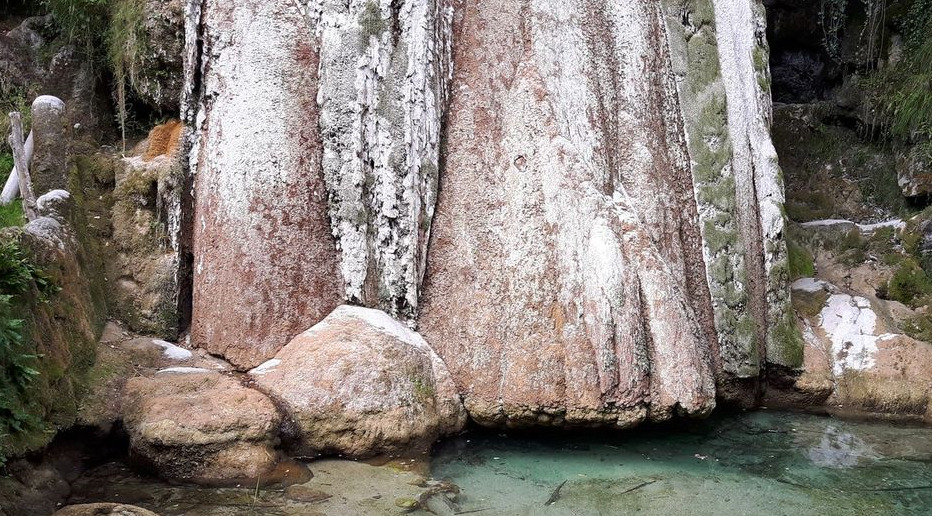
La Earthcache / The Earthcache
► Contexte géologique local
Au Nord du village de Termes, la Sou a creusé son lit jusqu'à être au contact de deux formations paléozoïques, des calcaires du Dévonien et des schistes ampélitiques du Silurien.

Le mariage de cette rivière et de ces formations a conduit à la mise en place d'un Adoux, sculpteur d'une formation pétrifiante étonnante.
► Les formations paléozoïques de Termes
~ Les Ampélites du Silurien
Les ampélites sont un matériel schisteux mis en place il y a 420 Ma par d'importants dépôts d'argiles riches en matières organiques dans une mer calme.
L'orogenèse hercynienne les a ensuite compressés en une roche métamorphisée, l'ampélite.
Cette formation se caractérise par un très fin litage en feuillets, une couleur gris cendré à bleu-noir, une texture très fine (grains invisibles à l'oeil nu) et une sensation satinée au toucher.
Cette formation est imperméable, empêchant l'infiltration de l'eau météoritique à l'inverse des formations supérieures calcaires.

~ Les Calcaires du Dévonien
Au Dévonien, des dépôts marins calcaires se sont mis en place et se sont transformés en calcaire dolomitiques sur une épaisseur de 300 mètres.
Ces formations ont été fracturées pendant l'orogenèse hercynienne entrainant la dissolution puis recristallisation partielle du calcaire en veines de calcites.
Ces calcaires sont gris-bleus, non lités, à texture fine et striés de veines de calcite blanche.

La richesse en Carbonate de Calcium (CaCO3) rend cette roche sensible à l'altération chimique par l'eau, surtout les flux hydrothermaux acidifiée par le CO2.
Cela conduit à la mise en place d'aquifères carbonatés (karstiques) qui rejaillissent sous la forme d'annexes hydrauliques appelés Adoux.
► Les Cascades pétrifiantes de l'Adoux de Termes
A la sortie des gorges du Terminet, le cours de la Sou se situent à la limite entre les formations carbonatés poreuses des calcaires et celles imperméables des ampélites.
Au contact des ces formations rejaillit l'Adoux de Termes, annexe thermale hydraulique de la Sou caractérisée par une température constante (15.7 degrés) et une eau riche en CaCO3.
Le passage à l'air libre de ces eaux fortement chargées en bicarbonate de calciumen suspension provoque la mise en place de dépôts de formations superficielles, des tufs calcaires.
Le tuf calcaire est une roche sédimentaire calcaire continentale, grossièrement litée, parfois concrétionnée, de couleur blanche quand elle est pure.
Cette roche est caractérisée par de petites cavités (vacuoles) inégalement réparties.

Le tuf se met en place aux émergences de l'eau à petites cascades par précipitation de carbonate de calcium à partir d'eaux sursaturées en ions Ca2+ et HCO3-.
Cette précipitation s'explique par une chute rapide de la pression de CO2 de l'eau lors de son passage à l'air libre, déséquilibrant la réaction chimique vers le membre de gauche.

Selon le passage de l'eau au niveau de la cascade, le tuf peut prendre plusieurs formes :
- Dans les zones à large section, le CaCO3 se mélange à des débris végétaux et formant de larges concrétions blanches à texture vacuolaire rappelant celle de l'éponge.
- Dans les zones étroites, le cristallisation se fait au bout de concrétions qui s'allongent au fur à et à mesure, à l'image d'une stalactite.

► Local geological context
North of the village of Termes, the Sou has dug its bed until it comes into contact with two Paleozoic formations, Devonian limestones and Silurian ampelitic schists.
The marriage of this river and these formations led to the establishment of an Adoux, sculptor of an astonishing petrifying formation.
► The Paleozoic formations of Termes
~ The Silurian Ampelites
Ampelites are a schist material that was put in place 420 Ma ago by large deposits of clays rich in organic matter in a calm sea.
The Hercynian Orogeny then compressed them into a metamorphosed rock, ampelite.
This formation is characterized by a very fine layered bedding, an ash gray to blue-black color, a very fine texture (grains invisible to the naked eye) and a satin feel to the touch.
This formation is impermeable, preventing the infiltration of meteoritic water unlike the upper limestone formations.
~ Devonian Limestones
In the Devonian, limestone marine deposits were set up and turned into dolomitic limestone over a thickness of 300 meters.
These formations were fractured during the Hercynian orogeny leading to the dissolution and then partial recrystallization of the limestone in calcite veins.
These limestones are gray-blue, unlit, with a fine texture and streaked with veins of white calcite.
The richness in Calcium Carbonate (CaCO3) makes this rock sensitive to chemical alteration by water, especially hydrothermal flows acidified by CO2.
This leads to the establishment of carbonate (karst) aquifers which spill out in the form of hydraulic annexes called Adoux.
► The petrifying waterfalls of Adoux de Termes
At the exit of the Terminet gorges, the course of the Sou is located at the limit between the porous carbonate formations of the limestones and the impermeable ones of the ampelites.
In contact with these formations, Adoux de Termes, a hydraulic thermal annex of the Sou river, springs up again, characterized by a constant temperature (15.7 degrees) and water rich in CaCO3.
The passage in the open air of this water heavily loaded with calcium bicarbonate in suspension causes the establishment of deposits of superficial formations, limestone tuffs.
Limestone tuff is a continental limestone sedimentary rock, coarsely lined, sometimes concreted, white in color when pure.
This rock is characterized by small cavities (vacuoles) unevenly distributed.
The tuff is put in place at the emergence of water in small cascades by precipitation of calcium carbonate from water supersaturated with Ca2 + and HCO3- ions.
This precipitation is explained by a rapid drop in the CO2 pressure of the water during its passage into the open air, unbalancing the chemical reaction towards the left limb.
Depending on the passage of the water at the level of the waterfall, the tuff can take several forms :
- In areas with a large section, CaCO3 mixes with plant debris and forms large white concretions with a vacuolar texture reminiscent of that of a sponge.
- In narrow areas, crystallization takes place at the end of concretions which gradually lengthen, like a stalactite.
► Sources bibliographiques / Bibliographical sources
Les Questions / The Questions
Questions pour valider :"Pétrifications à l'Adoux de Termes"
Questions to validate: "Petrification at l'Adoux de Termes"
Depuis le parking, suivez les différentes indications de directions (ThrealHeads).
From the car park, follow the various directions (ThrealHeads).
- Question 0 : En arrivant à la cascade, prenez une photo de vous ou d'un élément vous appartenant avec celle-ci en arrière plan (mais pas la partie de droite ou se trouvent les zones d'observation).
Cette photo devra au choix nous être transmise avec les réponses ou être ajoutée à votre log.
-Question 0 : When you arrive at the waterfall, take a photo of yourself or an element belonging to you with it in the background (but not the part on the right where the observation areas are).
This photo must either be sent to us with the answers or added to your log.
Point 1 : N 43° 00.344 E 002° 33.264
Vous voici à 20 mètres avant le bout du chemin. Mettez-vous dos à la rivière et observez la roche devant vous à l'affleurement.
You are 20 meters before the end of the path. Stand with your back to the river and observe the rock in front of you at the outcrop.
- Question 1 : Décrivez cette roche et déduisez-en sa nature. Est-ce cette roche qui est à l'origine des pétrifications de Termes ?
- Question 1: Describe this rock and deduce its nature. Is it this rock which is at the origin of the petrification of Termes?
Point 2 : N 43° 00.345 E 002° 33.275
Vous voici face à la base de la cascade de l'Adoux et de la Sou (photo WP2).
Here you are facing the base of the Adoux and Sou waterfalls (photo WP2).

- Question 2 : Décrivez le bloc sous la zone rouge A. Est-ce cette roche qui est à l'origine des pétrifications de Termes ?
- Question 2: Describe the block under the red zone A. Is it this rock which is at the origin of the petrification of Termes?
- Question 3 : Avancez avec prudence vers la zone verte B. Décrivez la roche sous cette zone et tatez la. De quelle formation s'agit-il ? Comment expliquez sa texture ?
- Question 3: Proceed with caution towards green zone B. Describe the rock below this zone and test it. What training is it? How to explain its texture?
- Question 4 : Nommez les formations visibles sous la zone jaune C et expliquez leur mise en place.
-Question 4 : Name the formations visible under the yellow zone C and explain their placement.
Vous pouvez vous loguer sans attendre notre confirmation,
mais vous devez nous envoyer les réponses en même temps soit par mail via notre profil (
fafahakkai), soit via la messagerie geocaching.com (Message Center).
S'il y a des problèmes avec vos réponses nous vous en ferons part.
Les logs enregistrés sans réponse seront supprimés.
You can log this cache without waiting for our confirmation, but you must send us the answers at the same time, by e-mail via our profile (fafahakkai) or by the system of Message Center of geocaching.com.
If there is a problem with your answers we will notify you. The logs recorded without answers will be deleted.
Rappel concernant les « Earthcaches »: Il n'y a pas de conteneur à rechercher ni de logbook à renseigner. Il suffit de se rendre sur les lieux, de répondre aux questions ci-dessus et de nous renvoyer les réponses.
Reminder concerning "Earthcaches": there is neither a container to look for nor a logbook to sign. One need only go to the location, answer to the differents questions and send us the answers.